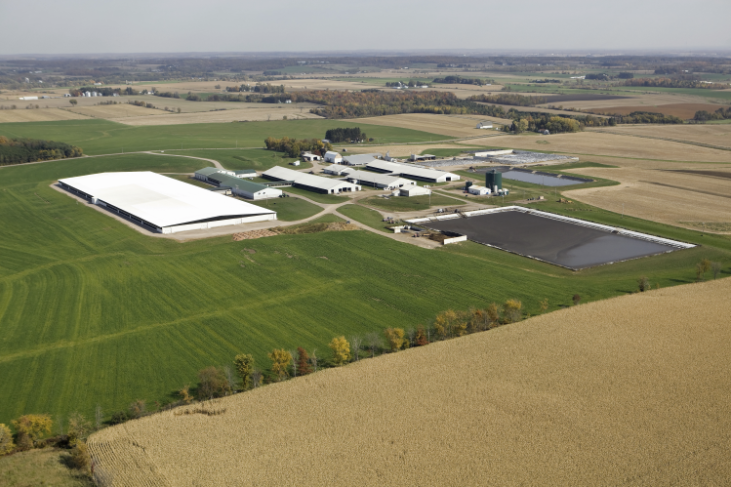At the 2022 Dairy Strong Conference hosted by Wisconsin’s Dairy Business Association in January, Jordan Kraft Lambert, vice president of business development at VAS, broke down the problem the planet is facing, how it happened, what it means for U.S. dairy, what others are doing about it and what dairy producers can do about it.
“I didn’t used to believe in climate change until I embarked on this particular journey,” said Kraft Lambert, who was part of a task force at VAS to learn more about carbon and global warming.
“I’m actually not here to convince you,” she assured. “What I’m here to do is tell you that you are a part of a global carbon system, and as a part of a global carbon system, you should understand the language.”
While Kraft Lambert admitted the landscape of climate change is constantly changing in political, scientific, economic and microbiologic circles, she said U.S. dairy producers are well-suited to engage in carbon farming for three reasons.
1. Dairy producers can work with tiny things like seeds and microbiomes, while also looking at things in a global context.
2. Measuring will play a significant role, and the dairy industry has been better than most industries at measuring a lot of different things over the course of its lifetime.
3. For as long as dairy producers have been planting seeds that grow into feed and feeding cows that feed, they have been carbon farmers.
How did this happen?
Radiation from the sun enters Earth’s atmosphere to warm the surface of the planet. What isn’t absorbed by oceans and land is supposed to return directly to outer space, however, gases such as carbon dioxide, methane, nitrous oxide and water vapor can trap the additional heat in the earth’s atmosphere – this process is known as the greenhouse effect.
The natural carbon cycle has been occurring on Earth for a very long time. In a simplistic view, plants pull carbon dioxide from the atmosphere, humans and animals consume the plants, they exhale carbon dioxide back into the atmosphere, and the cycle continues.
The difference is that humans are also extracting ancient carbon or fossil fuels that when burned, release carbon dioxide into the atmosphere. “It’s not a part of a cycle,” she said. “It’s a one-way street.”
This use of ancient carbon has been happening since the Industrial Revolution in the late 1700s. The inventions spurred by this revolution from steam engines to automobiles have been beneficial to society, but at a cost to the climate. “We invented air travel and air conditioners – really fabulous things that made the world a nicer place to live,” Kraft Lambert said. “But we didn’t see a lot of the more negative effects, which was that CO2 is accumulating in the atmosphere and raising temperatures.”
What does it mean for me?
A life cycle assessment done in 2008 showed the dairy industry contributes just 2% of all greenhouse gas (GHG) emissions in the U.S. While it may seem small, Kraft Lambert said, “A little of a lot is a lot. … two percent of greenhouse gas emissions in the United States that we contribute as the American dairy industry is still quite a lot.”
There are two main types of carbon that are part of this discussion. Carbon dioxide (CO2) is the main form on the fossil fuel side, where methane (CH4) is what the livestock industry is primarily emitting.
“CH4 is, depending on whose math you’re using, between 23 and 30 times more powerful at warming the atmosphere than CO2 is,” she said.
While methane from livestock will warm the earth more, it also means reductions by livestock operations can make a bigger impact. “The oil and gas industry is going to have to work 23 times harder than we are to try to make some reductions,” she said.
In fact, the global livestock industry was highlighted as a solution at COP26, the most recent United Nations Climate Change Conference in Glasgow in November.
What are others doing about it?
After COP26, every supply chain globally is experiencing pressure from multiple sources – governments, markets, stockholders, employees and society – to understand what their carbon footprint is and their plans to reduce it.
Big banks, its major investors and insurers, and financial regulators have pledged to incorporate carbon emissions into their most fundamental decisions. Some are eliminating lending to coal mining and utilities using coal for more than 20% of their total energy.
As a result of social pressure more than regulatory pressure, over one in five of the world’s 2,000 largest publicly listed companies have committed themselves to net zero emissions.
The transportation oil and gas industries are using satellites and infrared technology to identify and then seal methane leaks on pipelines. They are also looking at mechanical trees to sequester carbon from the air to make bioplastic pellets.
Three market mechanisms have been deployed as paths toward offsetting current emissions. They are:
-
Compliance markets: These are for companies that have been legislated to be regulated through cap and trade. “In California, for instance, you’ve got the transportation sector that has been capped, and they’re allowed to trade outside of their supply chain to find sources of carbon that are less fossil based,” Kraft Lambert said, which is why low carbon fuel standards (LCFS) credits exist for biodigesters.
-
Voluntary markets: Non-regulated companies that want to reduce their carbon footprint are participating in voluntary markets. The current credit values in these markets are quite low, but Kraft Lambert said there is potential for substantial increases here as supply and demand grows.
- Internal reductions: Some companies are tracking carbon emissions throughout their supply chains and taking intentional steps to reduce their emissions.
“We’re still witnessing the birth of this brand-new marketplace, and there are some problems with it,” Kraft Lambert said.
For these carbon credit markets to function well, she said there needs to be shared principles to define, verify and value carbon credits; core contracts for purchasing credits; trading and post-trade infrastructure; a consensus for the proper use of carbon credits; mechanisms to safeguard the market; and clear demand signals to improve credit prices.
What is the dairy industry doing about it?
Kraft Lambert applauded the dairy industry for being very proactive and making commitments to be a part of net zero initiatives.
She sees a few possible scenarios for the industry in the future. The first is that dairy producers can obtain monetizable credits. Another scenario is for dairy producers to earn a premium for carbon neutral or net negative milk. Lastly, there’s a chance producers will have to reduce their emissions to earn the right to continue farming.
What can dairy producers do about it?
Regardless of what path the industry goes, measurements will be necessary.
“Even if you don’t change anything right now, measure as many things as possible – feed, health of your animals, soil, carbon, whatever you can get your hands on,” she said.
The measurements can serve as a record of what you were doing in 2022. With the data, it will be easier to explore what could be changed on the farm, the impact it would have on emissions and, if implemented, what it did.
Dairy producers can impact their farm’s carbon levels by reducing enteric emissions (burps and flatulence from cows), lowering manure emissions or sequestering more carbon (trapping it in plants and soil).
Kraft Lambert suggested implementing carbon-friendly practices in small ways, like putting cover crops on a few acres. Then the change can be evaluated for what went well and what negatives would need to be managed if implemented on a larger scale.
Advocate to build demand
“There are some things that we need to do to create really robust carbon credit systems for all dairy farmers globally,” Kraft Lambert said.
These range from better ways to measure emissions and carbon sequestration to accounting for methods already in use on farms, higher credit prices, and more available products and protocols.
It is imperative for dairy producers to advocate for their best interests. “Be a part of the conversation,” she said. “You are all carbon farmers, and there will be markets that are created around what you’re able to do.”
Asking farm suppliers, feed additive companies, nutritionists and others for what is needed starts to build demand.
“There are people who are willing to spend money on carbon solutions. So show them a market signal. Show the innovators in that space who are creating these credits that you’re there and that you’ve been doing this and that you have something to offer for having done so,” Kraft Lambert said.
These investors can help provide the tools and support higher carbon prices that the industry needs to accomplish its goals.
Reducing climate change and the amount of carbon in the atmosphere is a global undertaking. Stepping up and speaking up as markets and solutions emerge can speed up efforts and fill the needs for carbon/dairy farmers wanting to take part in these efforts.







